 A common belief among sales and distribution professionals is that “names sell”. As in, films starring famous actors (“names”) are more marketable than films without any famous names. But how true is this?
A common belief among sales and distribution professionals is that “names sell”. As in, films starring famous actors (“names”) are more marketable than films without any famous names. But how true is this?
Bruce Nash and I teamed up to find out in the latest of our research projects for the American Film Market.
Studying all US-produced movies shot in 2017 we looked to see if having a well-known actor in a leading role helped get a film into cinemas. We focused on films made in 2017 to ensure that they have had time to either find a theatrical release or not. For example, a few of the films shot in 2017 have only recently been released, up to two and a half years after principal photography was completed.
Let’s start by looking at what types of films typically star famous actors, and then we can move on to testing the connection between star power and the type of theatrical release films receive.
What types of independent films have a star in the cast?
Based upon The Number’s Bankability Index, we created a list of well-known movie stars at the beginning of 2017 (see the notes section at the end for details). We then analyzed the top-billed cast for each of the 1,000 films in the dataset to see if each film had a star in their cast.
Out of 877 independent films, a little under 40% (338 in total) had a famous cast member. The number of stars varied considerably by genre, though. Only a fifth of horror films (21%) had a star, while about a half of thrillers and action did (50% and 51% respectively).
Relatively speaking, stars appear much more in comedies, thrillers, and action movies, where name-appeal is more likely to sell a film.
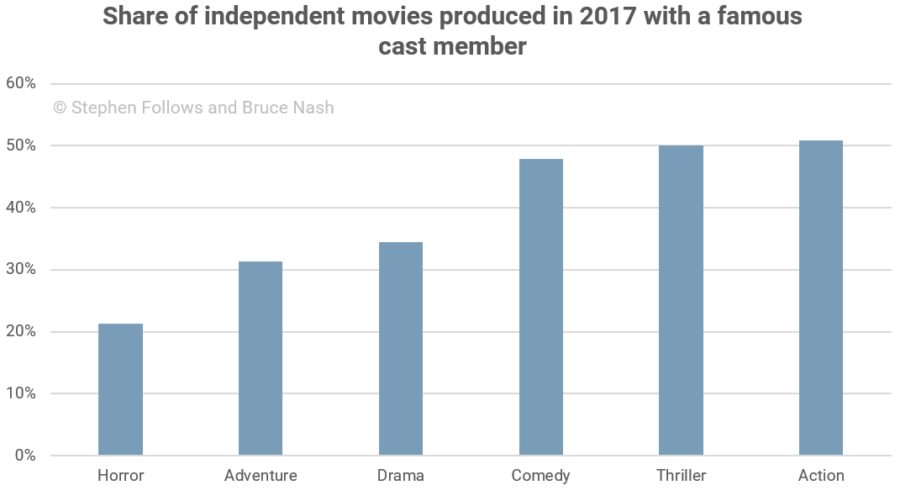
Although we want to focus on independent movies in this article, just for a sense of scale, we ran the same process for movies produced by the major studios.
As one would expect, studio films have star casts in most cases—103 out of 123 studio films had a star in their cast. The only genre with significantly fewer stars is horror. All other genres have a greater than 80% chance of being led by a star.
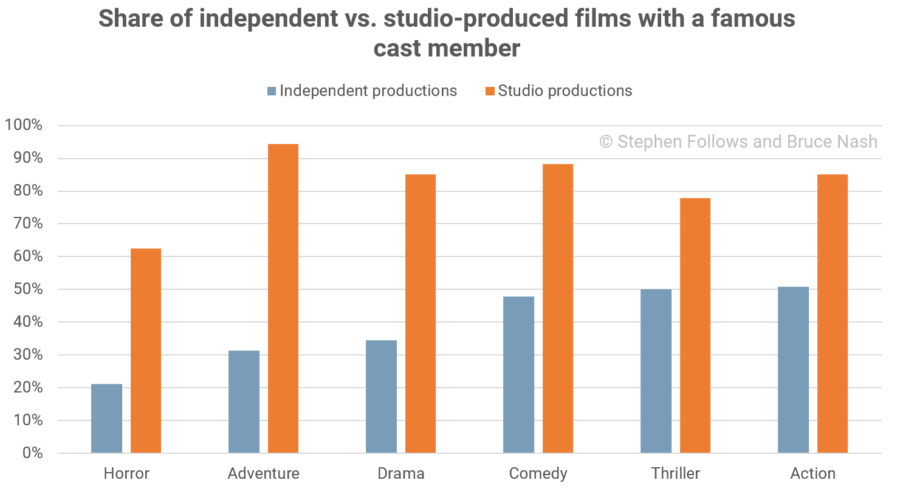
Now that we know where fame is found, let’s look at how this correlates with release outcomes.
How does having a famous cast affect your chances of a theatrical release?
Focusing on independent productions, we split the films into four possible outcomes (in all cases, we’re talking about the “Domestic” market, aka the United States and Canada).
- No theatrical release – These films had no commercial theatrical release domestically. They may have had a premiere in a cinema, and played in film festivals, but they never announced a theatrical release for paying customers.
- Nominal release – These films officially have theatrical release dates but no box office figures have been reported, meaning that it was very likely to have been an extremely small release, possibly in just one or two cinemas.
- Small release – Films which grossed between $1 and $100k at the domestic box office.
- Large release – Films which grossed over $100k at the domestic box office.
The chart below shows the percentage of independent films at each release scale that have a star in their cast. For example, 25% of films with no release (i.e., that went direct to video or to a streaming platform) had a star.
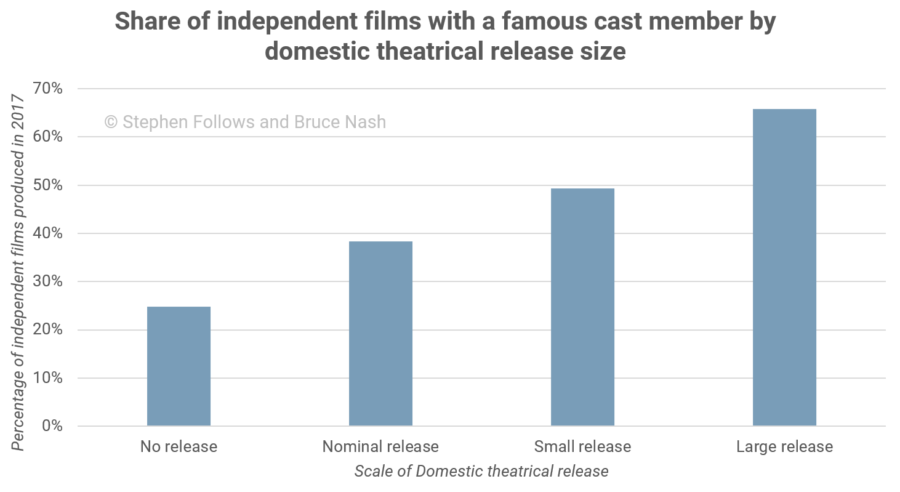
In which genres do stars burn brightest?
Finally, let’s split these films by genre and look at how having a star affects their eventual release.
In all cases, having a well-known actor in a film is helpful to securing a theatrical release, but the effect varies a lot by genre.
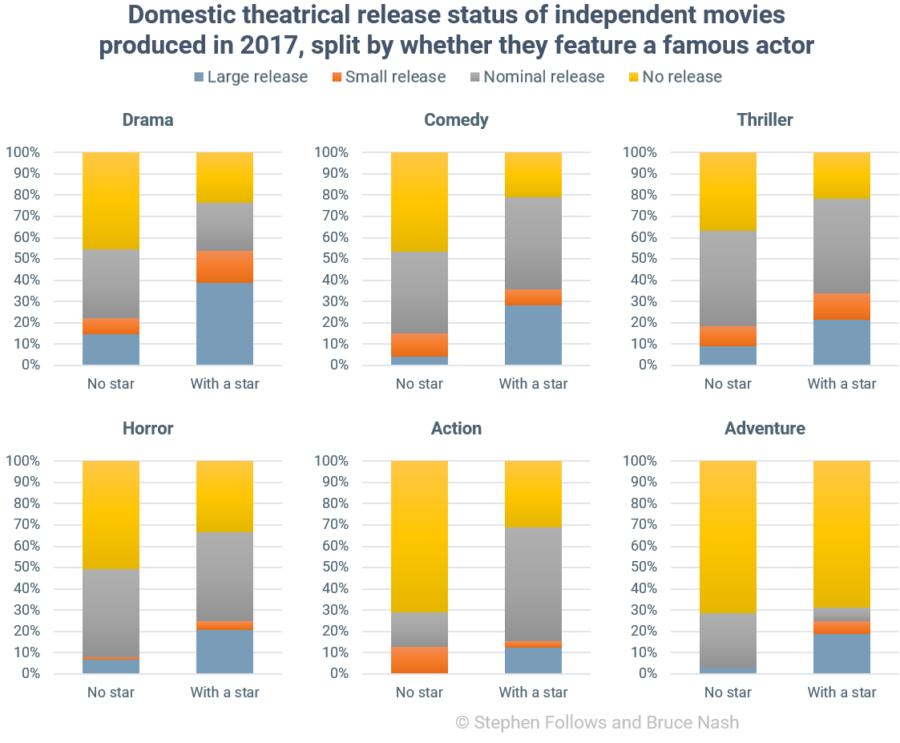
Across most genres, casting a star significantly increases the chance of having a theatrical release. The only exception is adventure films, 70% of which go direct-to-video, with or without a star. That said, if you’re making an adventure film and want a major theatrical release, you have to have a big star involved (we only found one independent adventure that got a substantial theatrical release that didn’t have some star power).
For action movies, having a well-known star dramatically increases the chances of getting some sort of theatrical release – 70% of action movies with lesser-known actors go direct-to-video, while 70% of action movies with a well-known actor get some sort of theatrical release. There isn’t a single action movie in our dataset that got a significant theatrical release without a major star on board.
For dramas, comedies, thrillers, and horror movies, having a star also dramatically increases the chance of a substantial theatrical release. That said, there are examples in all of these genres of films with no big-name actor that got big releases (think of the likes of Moonlight in the drama category, or the comedy The Big Sick). These four genres are the ones where a strong script or original idea still gives a film a shot at breaking out (but even then, recruiting some well-known talent can help).
Conclusion
Consumers respond to branding, feeling safe to try new things when they come under the banner of an already trusted brand. If Coke brings out a new drink, then people will be much more likely to try it than if it was invented by an unknown person or company. The movie business is no different, albeit with some strange ‘brands’. Some major studios have valuable brand appeal (i.e. Disney and all its myriad subsidiaries like Pixar, Marvel and Star Wars) while others struggle to convey much with their name alone.
As independent filmmakers, we don’t have this company brand so must rely on two other ‘brands’ – genre and star power. To many, saying that it’s a romantic comedy or a psychological horror movie will be enough to create interest. But some films cannot rely simply on their genre classification – even those within well-defined genres need to stand out. This is where star power comes in.
A famous cast can help elevate a film from being “just another comedy” to “that comedy starring Mel Gibson and Marky Mark.” Arguably, independent films need this more than studio pictures, due to the lack of a company brand, no established audience and no locked-in distribution channels.
As we have seen, not all films are equally reliant on star names. In a previous article, we showed how the key to a breakout drama is getting extremely good reviews (i.e. a Metascore in the high 80s and 90s), and it turns out that only about a third of independent dramas have stars in their cast.
Conversely, the genres which seem most connected to star power have the weakest connection with what film critics think, namely romantic comedies and horror films.
Some film audiences want five-star reviews, while others are content with watching just a couple of stars so long as they’re big ones. In either case, it’s yet another example of how the producers’ mantra should always be “Know thy audience.”
Notes
All the films studied today are feature films shot in the United States, or made by US-based production companies, and completed in 2017. It’s possible that some of these films have not yet reached cinemas, and so in the fullness of time the figures may change slightly. That said, we are conducting this research in early-September 2019 and so the vast majority of films have either reached cinemas or never will.
One of the challenges for this article was deciding what makes someone a star. The selection criteria we used is that someone must have averaged over one credit per year in the 10 years leading up to January 2017, and have a domestic Bankability value (which is roughly what we expect they would be paid to appear in an independent film) above $500,000/movie. This corresponds to the top 2% of actors working regularly in the domestic film industry.
When measuring the star power of a movie, we focused on the top six billed actors, to exclude cameos and incidental appearances.


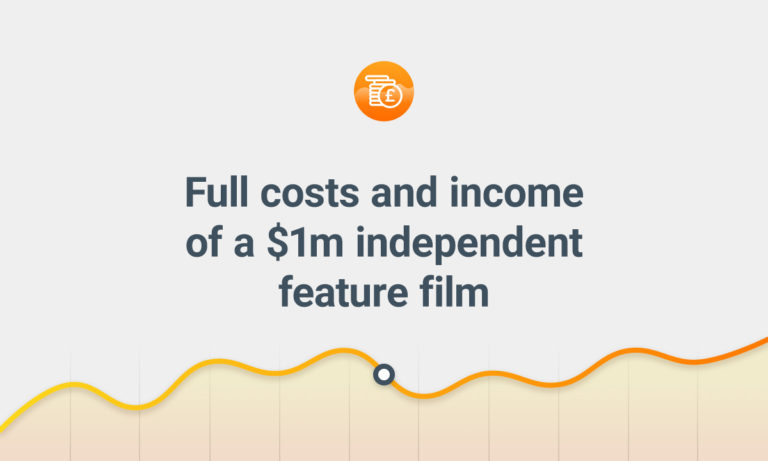


Comments
great insights thank you for the info!
This is a really interesting study, thanks Stephen! I think it’s worth mentioning, that in this day and age of VOD and streaming, while theatrical release is desirable, if a film does not have a theatrical release, it doesn’t necessarily mean that it’s a ‘failure’ or that it didn’t do well in terms of distribution. A side note from this article, but these conclusions shouldn’t be a deterrent for independent filmmakers! 🙂 Thanks again for your work, I love reading your research and findings.
Hi Stephen,
Fascinating research. Thanks so much. I am a writer who teaches Advanced Screenwriting at Columbia College Chicago. (Most of my work has been in theatre. http://www.grantrobbin.com). I’m very excited about a screenplay concept I have with a protagonist who doesn’t look Middle-Eastern, but later discovers he is. It is basically a drama with several action sequences. Do you think this could possibly be done as an independent film with an unknown actor who appears white, but his ethnicity is actually Middle-Eastern? (Don’t know of any Middle-Eastern stars that would be right; Rami Malek looks Middle-Eastern to begin with.) I have an Oscar-winning friend who is having a similar problem getting a script produced that would require, ideally, a famous Native American actor for the lead. Looks like this article was written pre-pandemic and before casting demanded actors of the nationality they are portraying. I’d greatly appreciate it if you could shed some light on the plausibility of my project. Thanks very much. Grant
Perhaps if your lead character turns out to be a Middle Eastener somewhere on the albino spectrum then it can widen your casting options and would be an added twist for your screenplay. This might lure a bigger fish producer in who has contacts with bigger stars. Could add some social commentary on whitewashing as food for thought sprinkled in maybe?